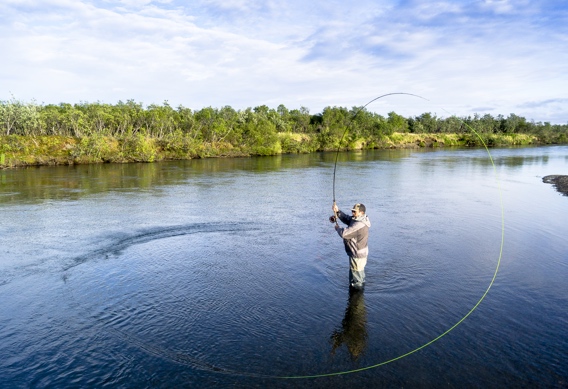
Whether we’re searching for steelhead on the Dean, swinging flies for kings on the Kanektok, or soaking sculpins for massive Naknek rainbow trout, we do a lot of spey fishing at our lodges.
Therefore, as you might expect, we give our share of spey instructions as well, and today we share with you a few of the most common spey casting tips we give to our guests on a regular basis.
- Slow Down. We’ve often said anyone could teach spey casting if they just kept repeating ‘slow down.’ Rushing throughout the cast is one of the most common casting faults we see from our anglers. So, if things don’t feel right, take a breath, regroup, and try slowing each part of the cast down (lift, set, sweep, etc). Remember, slow and steady wins the race when it comes to skagit-style spey casting.
- Watch Your D-Loop. One of the most important fundamentals of spey casting is what some like to call the ‘180 degree rule,’ which states that when it comes time to make your forward cast, your anchor, D-Loop, and target must be in a straight line in order to produce an efficient cast. How can you tell exactly if all three are lined up? Watch your D-Loop! As your come around with your sweep, watch as you form your D-Loop behind you. Just before its lined up 180 degrees away from your target, go ahead with your forward cast. That will allow the line to track in a straight line to the target. Always watch your D-Loop, it makes a huge difference.
- Use More Bottom Hand. For many anglers making the transition from traditional (single hand) fly casting to spey casting, the tendency is to use too much top hand throughout the cast. On the forward cast alone, too much top hand causes the rod tip to track in a wide arc, rather than a straight line, producing wide open loops. Instead, power should be applied on the forward cast by pulling with the bottom hand rather than pushing with the top hand. The same goes throughout every part of the cast as well (set, sweep, etc.). The more bottom hand your incorporate into each sequence of the cast, the more work you divvy up amongst both hands making the entire cast easier on your body.
Well written! I can see the motion as I read. Thanks! Could you post something on how to build a well-balanced Skagit outfit. I’m never sure if I have the right head and leader set up for my 7 wt. 11.6 ft. switch. I have a bunch of MOW tips in light. Not sure if these are right for a 7 wt.
Hi Mike
Thanks for the kind words. Happy to hear you found the explanations easy to follow. We’ll see what we can do about putting something together regarding building a balanced Skagit outfit.
In the meantime, try checking out the following posts we’ve put together in the past. For finding the right head, check out these spey line recommendations from a few of the most common spey line manufacturers. Here you’ll find great recommendations for skagit heads for most modern rod models. If you’re rod is not listed, try looking at other comparable 11′ 6″ 7 wt rods to get a great ball park idea of a head that will work well for your rod.
As far as MOW tips, Medium weight MOW’s generally pair best in the 7-weight rod range if ‘castability’ is your only prerogative. However, since fishing conditions tend to dictate most of our tackle decisions, its not out of the question to use ‘Light’ (which sink slower) or even ‘Heavy'(which sink faster) MOW tips to reach a desired depth. Odds are a selection of Medium MOW tips will be the most versatile for your switch rod, but that’s not to say that Light or Heavy tips couldn’t be used if the conditions called for it.
For leader length, when fishing a skagit setup, we like to keep things really simple with a straight shot (3-5 feet) of 12-15 lb. Maxima Ultragreen attached to the sink tip (or MOW tip). Personally, I use 12 lb. maxima when fishing for steelhead, and 15 lb. when swinging flies for king salmon. When swinging for trout on a skagit setup, I typically fish a lighter tippet, but still fish a straight shot of leader material connected to the sink tip with a loop to loop connection.
Here’s some more info on some basic spey rigging that we put together in the past.
Hope that helps Mike. We’ll get cracking on putting together some more posts on building balanced skagit outfits. Thanks for reading!